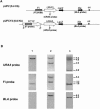Inactivation of the FCY2 gene encoding purine-cytosine permease promotes cross-resistance to flucytosine and fluconazole in Candida lusitaniae
- PMID: 16048910
- PMCID: PMC1196221
- DOI: 10.1128/AAC.49.8.3101-3108.2005
Inactivation of the FCY2 gene encoding purine-cytosine permease promotes cross-resistance to flucytosine and fluconazole in Candida lusitaniae
Abstract
In a previous work, we described the possible relationship between a defect of purine-cytosine permease and the acquisition of a cross-resistance to the antifungal combination flucytosine (5FC) and fluconazole (FLC) in Candida lusitaniae (T. Noël, F. François, P. Paumard, C. Chastin, D. Brethes, and J. Villard, Antimicrob. Agents Chemother. 47:1275-1284, 2003). Using degenerate PCR and chromosome walking, we cloned two FCY2-like genes in C. lusitaniae. Northern blot analysis revealed that only one gene was expressed; it was named FCY2. The other one behaved as a pseudogene and was named FCY21. In order to better characterize the possible role of FCY2 in cross-resistance to 5FC-FLC, disruption experiments with auxotrophic strain 6936 ura3(D95V) FCY2 with an integrative vector carrying the URA3 gene and a partial sequence of the C. lusitaniae FCY2 gene were undertaken. Southern blot analysis revealed that homologous recombination events occurred in all transformants analyzed at rates of 50% at resident locus FCY2 and 50% at resident locus URA3, resulting in the genotypes ura3 fcy2::URA3 and ura3::URA3 FCY2, respectively. It was then demonstrated that only transformants harboring a disrupted fcy2 gene were resistant to 5FC, susceptible to FLC, and resistant to the 5FC-FLC combination. Finally, complementation experiments with a functional FCY2 gene restored 5FC and FLC susceptibilities to the wild-type levels. The results of this study provide molecular evidence that inactivation of the sole FCY2 gene promotes cross-resistance to the antifungal association 5FC-FLC in C. lusitaniae.
Figures





References
-
- Behar, S. M., and G. M. Chertow. 1998. Olecranon bursitis caused by infection with Candida lusitaniae. J. Rheumatol. 25:598-600. - PubMed
-
- Brown, T., and K. Mackey. 1997. Analysis of RNA by Northern and slot blot hybridization, p. 4.9.1-4.9.16. In F. M. Ausubel, R. Brendt, R. E. Kingston, et al. (ed.), Currents protocols in molecular biology, vol. 1. John Wiley & Sons, New York, N.Y. - PubMed
MeSH terms
Substances
Associated data
- Actions
- Actions
LinkOut - more resources
Full Text Sources
Miscellaneous

